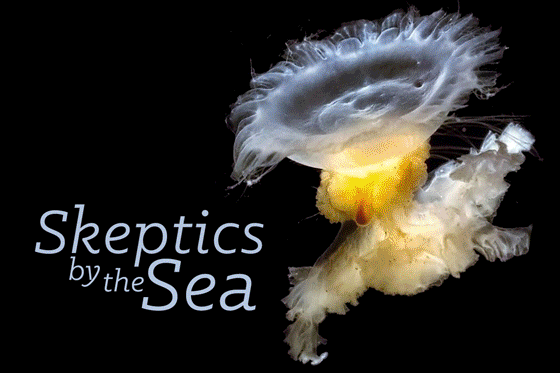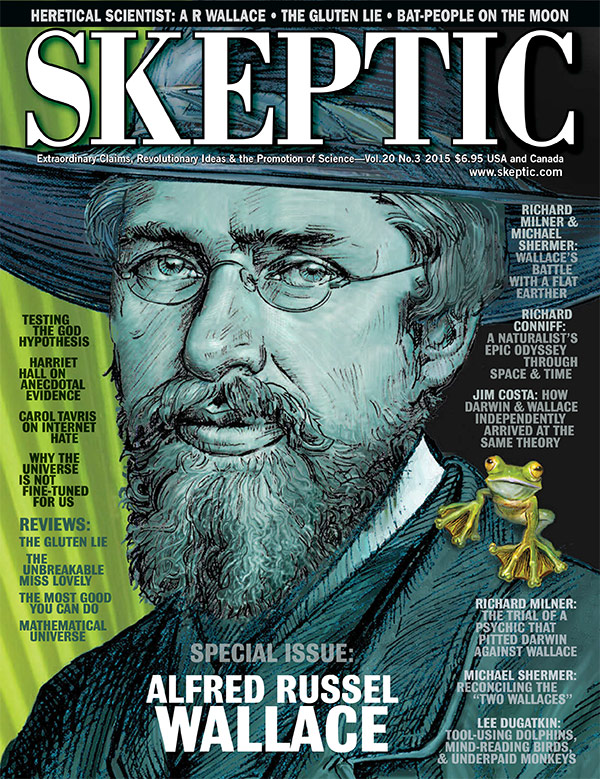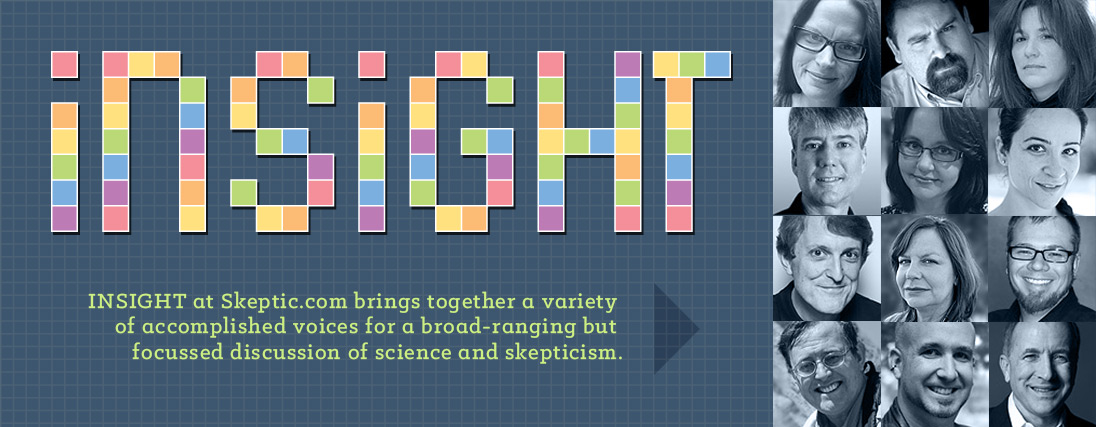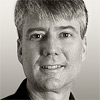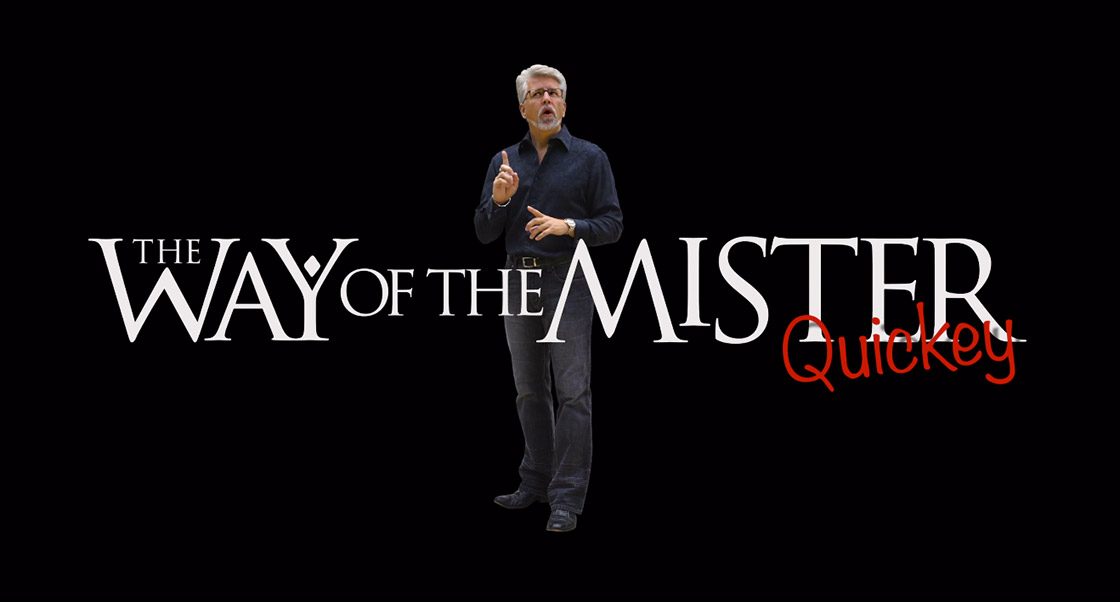About this week’s eSkeptic
In this week’s eSkeptic, Dave E. Matson critiques Douglas J. Navarick’s article “The ‘God’ Construct: A Testable Hypothesis for Unifying Science and Theology,” which appeared in Skeptic magazine 20.3 (2015). If you havent yet read that article, you may want to read it first, then come back here and read Matson’s challenge (below), followed by Navarick’s response.
Debating The “God” Construct
by Dave E. Matson
Douglas Navarick has obviously given some thought to “The ‘God’ Construct,” but the howlers I encountered robbed it of any credibility. For example: “Abiogenesis must be considered speculative considering that every cell ever observed has come from another living cell.”
I have yet to hear anyone in the science of abiogenesis claim that a living cell could appear naturally from scratch without benefit of prior cells! Given the complexity of even the simplest prokaryotes, such a claim would be preposterous. The goal of abiogenists is to recover the long pathway that eventually led to the first cells. If that is no longer possible, then the hope is to discover workable pathways. Navarick’s demand that abiogenists produce a living cell from scratch, comparing that to the failure to find compelling evidence for ESP, demonstrates a profound ignorance of abiogenesis. Yes, cells come from cells even as cats come from cats. However, the conclusion that cats cannot credibly come from non-cats (based on the observation that every single cat studied traces to a prior cat) is absurd in the light of evolution. Here we have a perfect analogy to Navarick’s attempt to discredit abiogenesis! Abiogenists will never witness a cell arising naturally from scratch; we will never observe evolution producing a cat from scratch. Neither predicts as much. Either path is a long, winding story!
Navarick derides abiogenesis for lacking a mechanism. In fact, there are plausible mechanisms now being sketched out. One can hardly expect all the bugs to be ironed out at this early stage; it’s a difficult field. Plausible mechanisms, complete with problems, are all that any science has to work with in exploring new areas. Do not confuse plausible mechanisms (with their inevitable problems) with “no mechanism in sight.”
The reason for keeping a supernatural deity out of science is that God is an ad hoc story that is compatible with everything and, therefore, explains nothing! Opening the door to supernatural “explanations” of any kind, which by definition cannot be investigated by the laws of nature—the only tool box we have—would turn science into a debating society unable to settle anything. We need not be dogmatic. If we observed a swimming pool that froze solid after the last person left, and became usable the instant someone jumped in, we might reasonably call it a “supernatural” event! However, we can’t even assume that such an event had a cause (let alone an intelligent, living cause) since that falls back on natural principles that might not apply to a supernatural event. Even if a supernatural event could somehow be certified, it could never be a part of any scientific explanation. It would forever be an isolated, odd-man-out fact sitting in a corner by itself. Any demand that scientific explanation include the supernatural is, therefore, totally wrong-headed.
Navarick’s minimalist construct of God is “A force that operates through and independently of natural laws.” Natural law is our best verification, within an appropriate range of measurement, as to what nature actually does. It is supported by countless laboratory experiments that are often done with unimaginable accuracy, and many experiments are conducted under extreme conditions. These experiments and measurements are done by highly trained observers who follow each others’ work in scientific journals, who are inclined to check the more interesting results by duplicating the experiments. To claim that a force exists that is not bound by natural law is to throw out the best attested facts in the world in favor of rank speculation! If Navarick’s unclear statement does not advocate the occasional suspension of natural law, then he must shear God of his super-powers. God then becomes another fixture in the natural world.
In reply to Stenger’s statement that there is no reason to assume that life could not have come from non-life, Navarick adds “But there is also no reason to assume that life could not have come from a supernatural source.” With every bit as much evidence, namely zero, we could have said “There is no reason to assume that life could not have come from a hair-brained Easter Bunny with magical powers!” Logically possible, I suppose, along with Bertrand Russell’s orbiting teapot, but hardly credible. Yet, if the Easter Bunny idea had an army of apologists refining it for two thousand years, if it were a part of everyone’s upbringing, it would have been the respectable story and God the silly one. In that sense the supernatural is not a legitimate alternative; it commands no more evidence than our hair-brained Easter Bunny. Countless apologetic works—complete with the usual errors, plus huge amounts of wishful thinking and cultural acceptance—do not establish scientific credibility. Presently, after we subtract the wishful thinking, and the naive thinking, scientific evidence for God is no better than that for a hair-brained Easter Bunny who possesses magical powers.
The “assumption” that abiogenesis will eventually show how life emerged from non-life should be seen as a practical conclusion rather than a philosophical dictum. Scientists who seek a career in abiogenesis do so precisely because the evidence is so suggestive, virtually begging for scientific explanations to connect the dots. These guys are not running on dogmatic gas despite some careless statements! They are motivated by evidence, evidence strong enough to risk a career on.
In sum, current problems in abiogenesis cannot be taken as support for a supernatural “alternative.” At present, to the extent that it is even a coherent concept, the supernatural is not a credible alternative at all. Evidentially—as in “zip”—it is on par with our hair-brained Easter Bunny sporting magical powers. Insightful theologians will often admit that God must be taken on faith, and science can’t run on that kind of faith. Therefore, trying to unify science and theology is like trying to unify apples and oranges. If they are squeezed together to such an extent that you can no longer tell the difference, then we no longer have apples and oranges. We have a mess! ![]()
About the Author
Dave E. Matson, a navy veteran and former programmer for Hughes Aircraft Company, graduated from San Diego State University in mathematics, his enthusiasm for the sciences almost supplying enough credits for an additional degree. Another major interest took in the study of Christian apologetics and creationist arguments which led to various informal publications scattered about the Internet, a study that gave him some feeling for epistemology (how we know). In recent years a continuing study of the sciences (introductory university textbooks—fat, serious, and still fun) with morning tea went hand in hand with photographing wild flowers throughout Southern California. Occasionally, Mr. Matson will drag out his ancient telescope (Celestron 5″) to view some event, usually with a few friends, and he is always good for a vigorous game of chess.
Abiogenesis: Hypothesis or Doctrine?
by Douglas J. Navarick
Matson’s objections to my article are based largely on misinterpretations of it and a gross oversimplification of the “God” construct, confusing it with stock conceptions of the supernatural and failing to recognize its potential for integrating diverse lines of research and for suggesting new insights. Listed below are my replies to Matson’s objections.
1. Complexity of chemical precursors. Matson writes, “Navarick’s demand that abiogenists produce a living cell from scratch, comparing that to the failure to find compelling evidence for ESP, demonstrates a profound ignorance of abiogenesis.” I never demanded that researchers produce a living cell from “scratch.” As shown in the second row of the table in my article, I considered evidence for the revival of dead cells. The level of chemical complexity that researchers started from was irrelevant. What mattered was creating life out of nonliving matter. The source of this misinterpretation may be that for the first row of the table, creating a living cell from chemicals, I highlighted the famous line of research beginning with the Miller-Urey experiments on producing amino acids from inorganic chemicals. However, the next row of the table, never mentioned by Matson, shows that I intended to include the broadest possible range of chemical precursors to life.
As for the ESP comparison, the evidence for ESP is arguably even stronger than that for abiogenesis. For ESP the evidence ranges from non-existent to weak (Daryl Bem’s studies: statistically questionable and many failures to replicate but something may be there) whereas for abiogenesis the evidence is, for now, simply non-existent.
I have not attempted to “discredit” abiogenesis as Matson claims. My goal has been to challenge the treatment of abiogenesis as an unassailable doctrine and return it its former status as a testable hypothesis as conceptualized by the originator of the term, Thomas H. Huxley, in a presidential address to the British Association for the Advancement of Science in 1870:
And thus the hypothesis that living matter always arises by the agency of pre-existing living matter, took definite shape; and had, henceforward, a right to be considered and a claim to be refuted, in each particular case, before the production of living matter in any other way could be admitted by careful reasoners. It will be necessary for me to refer to this hypothesis so frequently, that, to save circumlocution, I shall call it the hypothesis of Biogenesis; and I shall term the contrary doctrine—that living matter may be produced by not living matter—the hypothesis of Abiogenesis.1
Biogenesis can be refuted by a demonstration of abiogenesis. What would it take to refute abiogenesis, or at least make it seem less plausible? If no contrary evidence was possible—if 100 more years could pass without a demonstration of abiogenesis and yet it remained as believable as ever—then clearly it would be functioning as doctrines do in religions, as sources of comfort for the faithful, insulated from the harsh realities of empirical testing. It seems to be serving that function now. Calling abiogenesis a “practical conclusion rather than a philosophical dictum” does not make it any less a doctrine.
2. Building the “God” construct, one empirical step at a time. Matson writes, “the supernatural is not a legitimate alternative; it commands no more evidence than our hair-brained Easter Bunny.” My article shows how the “God” construct can be elaborated in the same way as any construct in science, by adding properties to it based on empirical evidence. The initial statement of the construct was simply,
A force that operates both through and independently of natural laws.
The evidence (not proof) against abiogenesis implies that this force is also creative; it makes things. In addition, the evidence against multiple genesis events discussed in my article implies that random processes may not have been responsible for producing the first living cell. The alternative to random in this context would be willful. So a tentative, more elaborated version of the “God” construct could be stated as follows:
A willful, creative force that operates both through and independently of natural laws.
Each property is tied to empirical observations and subject to falsification.
In addition, the “God” construct makes stronger predictions than the widely accepted, materialist alternative: The “God” construct predicts that efforts to create a living cell, no matter how sophisticated, will fail. Researchers doing these studies may be working on “plausible” ideas about the underyling mechanisms but no one could predict that any particular mechanism would work.
The same strong predictions apply to searches for shadow life on earth (weird organisms that came from a different genesis event than all known organisms) and searches for life elsewhere in the universe, including SETI, newly rejuvenated by a $100 million grant from Russian physicist and entrepreneur, Yuri Milner, for a 10-year multifaceted project called Breakthrough Listen. If after 10 years of Breakthrough Listen projects there was still no evidence for life beyond earth, how should those 10 years of negative results be interpreted, as evidence of absence or as absence of evidence?
In item 5, below, I will propose an additional property for the “God” construct based on empirical evidence, transcendence. It’s a crucial step because it serves to distinguish between chemical and non-material characterizations of life.
3. Cats from non-cats = ? Matson’s next paragraph about the cats coming from non-cats constructs bizarre analogies to make an unnecessary point. The disagreement Matson is expressing is with an argument I didn’t make. I did not suggest that the only acceptable evidence for abiogenesis would be to reconstruct the convoluted molecular pathways that supposedly led to the first living cell. Any strategy that created life out of non-life would settle the issue.
4. A multiplicity of ideas about mechanisms. Matson writes, “Navarick derides abiogenesis for lacking a mechanism.” What I actually said was that there was “no clearly established mechanism.” If, as Matson suggests, researchers have plausible ideas about underlying mechanisms, then we are not yet at the stage where there is a clearly established mechanism.
5. The next step: Is life an emergent or transcendent property of cells? Life is generally seen as an emergent property of the structures and biochemical reactions that make up living cells and not the product of any specific parts of the whole.2 Emergent means that a phenomenon depends on the relationships that exist among a set of elements. For example, in psychology there is the famous phi phenomenon that Gestalt psychologists used to support their principle that “the whole is more than the sum of its parts.” When two lights are turned on and off in rapid alternation, they are perceived as one light moving back and forth and not as two blinking lights. In our world of perception, 1 blinking light + 1 blinking do not equal 2 blinking lights. The appearance of movement is an emergent property of the temporal relationship between the two flashes of light.
For living cells, the “God” construct suggests a non-material alternative to emergence—transcendence. It is suggested here that life may be an add-on to the cell, an independent property that acts as a catalyst and allows biochemical reactions to occur without itself participating in those reactions. Life precedes the reactions; it does not result from them.
Is the transcendence principle just one more instance of the “rank speculation” that some see as part and parcel of any concept of the supernatural? Consider the following evidence.
Cryopreservation is a process of preserving living cells and tissues by freezing them in a way that keeps them structurally intact, i.e., prevents ice crystals from forming that could damage the cell wall. A wide variety of cells is routinely preserved in this manner, including fungi, bacteria, stem cells, oocytes, sperm cells, and embryos. All or most biochemical activity ceases in cryopreservation but the cells remain alive. As stated by D. E. Pegg3 in an article on the methodology of cryopreservation, “Unprotected freezing is normally lethal…#8221; but by adopting appropriate procedures “cooling can be used to produce stable conditions that preserve life.” Cells that remain alive in the absence of biochemical activity are evidence that life is not a product of, or equivalent to, biochemical activity. As the cell is thawed, the pre-existing property of life enables biochemical activity to resume. It is in this sense that life acts as a catalyst for the cell’s biochemical reactions. In light of this evidence, we may further elaborate the “God” construct as follows:
A willful, creative force that transcends material reality and operates both through and independently of natural laws.
References
- From a quote in Wikipedia: https://en.wikipedia.org/wiki/Abiogenesis
- Kirschner, M., Gerhart, M., & Mitchison, T. 2000. “Molecular ‘Vitalism’.” Cell, 100, 79–88.
- Pegg, D. E. 2007. “Principles of Cryopreseveration.” Methods in Molecular Biology, 368, 39–57.
About the Author
Douglas Navarick is an experimental psychologist and Professor of Psychology at California State University, Fullerton. He regularly teaches courses in Introductory Psychology and Learning and Memory. Since the 1970s Navarick has published research articles on choice behavior in pigeons and humans and is currently investigating how we make intuitive moral judgments.


